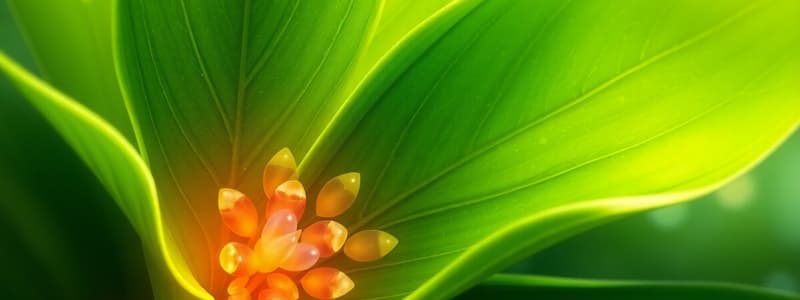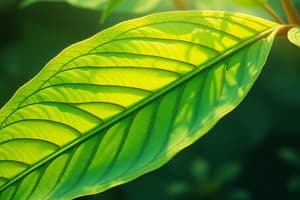Podcast
Questions and Answers
What is the defining characteristic of a sessile leaf?
What is the defining characteristic of a sessile leaf?
- It has a thick cuticle.
- It has a long petiole.
- The blade attaches directly to the stem. (correct)
- It is highly variable in shape.
The epidermis of a leaf does not have any stomata.
The epidermis of a leaf does not have any stomata.
False (B)
What tissue covers the upper and lower surfaces of a leaf?
What tissue covers the upper and lower surfaces of a leaf?
Epidermis
A leaf typically consists of epidermis, __________, and other tissues.
A leaf typically consists of epidermis, __________, and other tissues.
Match the following leaf components with their functions:
Match the following leaf components with their functions:
Which type of trichome is characterized as having a body that ends in two branches?
Which type of trichome is characterized as having a body that ends in two branches?
All covering trichomes are unicellular in nature.
All covering trichomes are unicellular in nature.
What is a peltate trichome?
What is a peltate trichome?
The ____________ trichome consists of radiating unicellular hairs.
The ____________ trichome consists of radiating unicellular hairs.
Match the types of covering trichomes with their descriptions:
Match the types of covering trichomes with their descriptions:
Flashcards
Branched Unicellular Hairs
Branched Unicellular Hairs
Hairs on plants that are single-celled and branched. Found commonly in plants belonging to the Cruciferae family.
Unbranched Unicellular Hairs
Unbranched Unicellular Hairs
Hairs on plants that are single-celled but not branched. Found commonly in plants belonging to the Senna genus.
Multicellular Hairs
Multicellular Hairs
Hairs that are formed of multiple cells and can either be branched or unbranched. These are more complex than unicellular hairs.
Uniseriate Multicellular Hairs
Uniseriate Multicellular Hairs
Signup and view all the flashcards
Biseriate Multicellular Hairs
Biseriate Multicellular Hairs
Signup and view all the flashcards
Sessile Leaf
Sessile Leaf
Signup and view all the flashcards
Epidermis (Leaf)
Epidermis (Leaf)
Signup and view all the flashcards
Stomata
Stomata
Signup and view all the flashcards
Mesophyll
Mesophyll
Signup and view all the flashcards
Lamina (Leaf)
Lamina (Leaf)
Signup and view all the flashcards
Study Notes
Leaf Structure
- Leaves begin as meristematic cells. After formation, these cells stop dividing and mature.
- Leaf growth occurs through cell enlargement, not cell division.
- A complete leaf has three main parts: leaf base, petiole (leaf stalk), and lamina (leaf blade).
Petiole (Leaf Stalk)
- Connects the leaf blade to the stem.
- Carries materials to and from the blade.
- Helps position the leaf for optimal light absorption.
Lamina (Leaf Blade)
- The broad, flat part of the leaf.
- Typically has a midrib and lateral veins.
- Contains tissues for photosynthesis and transport.
- Different leaf types display various forms, sizes, and structures.
Leaf Blade Structure
- Epidermis: The outer protective layer.
- Mesophyll: The photosynthetic tissue (contains layers, e.g., palisade and spongy).
- Vascular tissue: Veins for transporting water and nutrients.
Hairs (Trichomes)
- Extensions of epidermal cells, coming in diverse forms (e.g., branched or unbranched).
- Protect leaves from microbial organisms and insects.
- Some secrete oils or substances (glandular).
- Some are simply structural coverings (non-glandular).
Leaf Types
- Petiolate: A petiole connects the leaf blade to the stem.
- Sessile: The leaf blade attaches directly to the stem, without a petiole.
- Simple: A single undivided blade.
- Compound: Divided into leaflets, with each leaflet having its own stalk.
Stomata
- Small pores on the leaf epidermis, typically found on the underside.
- Regulate gas exchange (CO2 in, O2 out).
- Are guarded by guard cells.
- Various types of stomata exist with different subsidiary cell arrangements.
Mesophyll
- Contains palisade layer and spongy layer.
- Palisade layer responsible for photosynthesis.
- Spongy layer containing air spaces for gas exchange.
- Arrangement of mesophyll differs in various leaf types (isobilateral and dorsiventral).
Leaf Analysis and Structure (by image provided)
-
Many different types of leaves and plant species are shown in the images
-
Constituents, origins, chemical tests, and surfaces preparations are also listed.
Studying That Suits You
Use AI to generate personalized quizzes and flashcards to suit your learning preferences.




